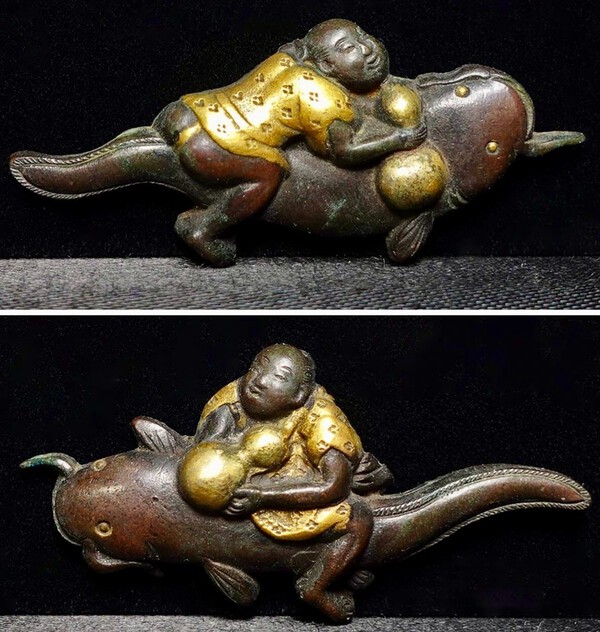-
Posts
307 -
Joined
-
Last visited
-
Days Won
2
Content Type
Profiles
Forums
Events
Store
Downloads
Gallery
Everything posted by Iaido dude
-
After a long and patient wait, I have just acquired my first tsuba in the composition of the Jesuit IHS Slanting Rays of Light (Shakoh) or Sacrifice for the Christian Faith (Kirishitan Ikenie). This is not a tokei tsuba (why would samurai and bushi adorn their swords with fittings depicting clock gears?). Here is my summary of this tsuba.
-

Menuki Hyotan Namazu ("Catching a catfish with a gourd")
Iaido dude replied to Iaido dude's topic in Tosogu
Thanks, Tim. I had that very strong sense that its practitioners are not at all interested in promoting a practice that should only be undertaken by the most sincere and committed student. It is said that novices who hope to train in a zen monastery must demonstrate their sincerity and commitment by meditating outside the monastery gate during winter (well, maybe not in the snow as some say). -

Menuki Hyotan Namazu ("Catching a catfish with a gourd")
Iaido dude replied to Iaido dude's topic in Tosogu
Thanks, Maurice. I’ve never quite known how to consider Musashi’s life and legacy. The modern myth was promulgated by popular historical works of fiction that are entertaining and that remain hugely popular. The truth about the man is, however, difficult to discern. I’m quite used to sustaining ambiguity and ambivalence, so he is not “problematic” in that sense. I learned very early in life not to put people on pedestals and not to hero worship. Lots to study and consider. And that is his gift. BTW, it is very difficult to find good instructional books/videos of Niten-Ryu Ha. Seems that Niten-do is more widely taught and practiced outside of Japan—even on-line virtual classes. -

Menuki Hyotan Namazu ("Catching a catfish with a gourd")
Iaido dude replied to Iaido dude's topic in Tosogu
I’ve been reading a translation of and commentary by five different accomplished martial artists on Musashi’s Dokkudo (The Way of Walking Alone). The conclusion is that during most of Musashi’s life and until he retired from dueling, he was a functional psychopath because he was ruthless, fearless, capable of being and staying mentally focused, and lacking in conscience. He was also a strategic genius as a warrior, originating a fighting school based on his famous two-sword fighting technique (Niten Ichi-Ryu), which I am learning through an international kendo organization. He has been largely canonized and serialized in books, manga, and anime as a “Sword Saint” through works of historical fiction and as an expression of cultural pride. However, by the strict code of Bushido, even he was viewed as monstrous—dishonorable and dangerous—by his father and the famous swordsmen of his time whom he systematically killed starting as a teenager, using guile, psychological warfare tactics, and strategic advantage even before he had any skills. Self-promoting and single-mindedly intent on achieving recognition and position, he was willing and able to do anything and everything to win. Then we read and admire his writings at the end of his life while in seclusion. And of course we have his paintings, calligraphy, and sword fittings that reveal a different side to this fascinating and complex human person. https://www.ebay.com...er=artemis&media=SMS -

Menuki Hyotan Namazu ("Catching a catfish with a gourd")
Iaido dude replied to Iaido dude's topic in Tosogu
-

Menuki Hyotan Namazu ("Catching a catfish with a gourd")
Iaido dude replied to Iaido dude's topic in Tosogu
Perhaps the finest depiction is by Kaneie, although I don’t think the one attributed to him below is by the master. Zen master Hakuin often depicted this story with gibbons. I just missed out on winning an auction of one of Hakuin's similar paintings. -

Menuki Hyotan Namazu ("Catching a catfish with a gourd")
Iaido dude replied to Iaido dude's topic in Tosogu
“Monkey trying to catch reflection of the moon” is another famous Zen story I have seen depicted on tsuba. The state of unenlightenment is like a monkey who is trying to catch the reflection of the moon in the lake and falls in and drowns. Jauce (attributed to Shoami) Kyoto National Museum (attributed to Shoami) -

Menuki Hyotan Namazu ("Catching a catfish with a gourd")
Iaido dude replied to Iaido dude's topic in Tosogu
-

Menuki Hyotan Namazu ("Catching a catfish with a gourd")
Iaido dude replied to Iaido dude's topic in Tosogu
This is the kozuka and menuki being sold as a set (they are likely not an original matching set) by Soryu and from which I borrowed an excellent writeup on the history and meaning of the Zen koan depicted. There is some hope that there is a matching tsuba. I don't collect soft metal tsuba, but putting together a themed collection including netsuke is attractive to me. Jason, if you know of a matching kozuka, do share if you'd like. https://www.ebay.com/itm/255796337621 -

Menuki Hyotan Namazu ("Catching a catfish with a gourd")
Iaido dude replied to Iaido dude's topic in Tosogu
Yes. Quite similar. Just wonderful. I am not experienced with menuki or shakudo. I suspect it is Edo period. I have seen a few Higo tsuba with this depiction, a large variety of netsuke, and of course the superb kazuka (I only have tsuba, no other fittings). There are examples of catfish menuki including modern reproduction, but I've only seen our two pairs that specifically depict this Zen story. -
I have only one pair of vintage menuki in my collection thus far. It depicts a famous Zen koan (see below) and appears to be shakudo, but is mumei. It's a motif that I hope to collect from depictions in paintings, tsuba, kozuka (Soryu antiques is offering a beautiful one), netsuke, and other Japanese arts/crafts. Josetsu (I can't confirm that this is "the oldest ink painting in Japan."
-

A quick test making a custom "luxury" tsuba box - here is the result
Iaido dude replied to Jorgensen's topic in Tosogu
Thanks, Jimi-san. These are all readily available materials. I’ve been thinking about how to build a locked aluminum travel case for tsuba with the features you worked out. Will share what I come up with. -

RE: Which tsuba schools incorporate rectangular/square hitsu-ana?
Iaido dude replied to Iaido dude's topic in Tosogu
There is a sense of the rectangular hitsu-ana being present from the time sukashi tsuba were being made and well into the Edo period (a nod to the earlier “archaic sensibility”). I’m guessing that forging a more primitive rectangular shape in either positive or negative silhouette is “simpler” than corresponding curved shapes, although the finding of both hitsu-ana shapes in the same tsuba indicates that that it was not for lack of skill on the part of the tsubako. -

A quick test making a custom "luxury" tsuba box - here is the result
Iaido dude replied to Jorgensen's topic in Tosogu
Beautiful. Was the entire box made from scratch? What fabric did you use? -

RE: Which tsuba schools incorporate rectangular/square hitsu-ana?
Iaido dude replied to Iaido dude's topic in Tosogu
Beautiful. Appears that at least part of the composition is comprised by karigane. The arrangement is also the Buddhist kuruma (noble eightfold path). The wide rim appears to be kaku mimi ko niku, which is more reminiscent of late Owari rather than Akasaka. What are the dimensions? Here is another one attributed to Owari: https://www.jauce.com/auction/n1155034292 -

RE: Which tsuba schools incorporate rectangular/square hitsu-ana?
Iaido dude replied to Iaido dude's topic in Tosogu
I think you are quite right, David. That reference to shrine was from an American Buddhist website. Definitely not shinto. I will correct the wording in my writeup for my own records. -

RE: Which tsuba schools incorporate rectangular/square hitsu-ana?
Iaido dude replied to Iaido dude's topic in Tosogu
Very nice composition on your Owari, Florian. Is that a rounded square mimi? -

RE: Which tsuba schools incorporate rectangular/square hitsu-ana?
Iaido dude replied to Iaido dude's topic in Tosogu
Here is a Kanayama in my collection with the motif of a water well 9rather than a window0, which may be a Buddhist symbol. I posted on this nearly a year ago, but not in relation to the shape of the hitsu-ana per se. The composition includes both the square hitsua-ana (buckets?) and a rectangular section above and below (the frame of the well with crank?). -

RE: Which tsuba schools incorporate rectangular/square hitsu-ana?
Iaido dude replied to Iaido dude's topic in Tosogu
Thank you, David. This tsuba looks very familiar. I think I’ve seen it or another with the identical composition previously. -

RE: Which tsuba schools incorporate rectangular/square hitsu-ana?
Iaido dude replied to Iaido dude's topic in Tosogu
-

RE: Which tsuba schools incorporate rectangular/square hitsu-ana?
Iaido dude replied to Iaido dude's topic in Tosogu
Thanks, David. I'm looking more intently at early sukashi tsuba. -

RE: Which tsuba schools incorporate rectangular/square hitsu-ana?
Iaido dude replied to Iaido dude's topic in Tosogu
-
I have two sukashi tsuba (I have attributed to later Shoami and later Owari) with multi-tiered rectangular hitsu-ana. I have begun to wonder when and where this design element was first incorporated and subsequently used. I am including a few pics from Owari To Mikawa No Tanko of a rare mokko-shaped Kanayama with multi-tiered rectangular kogai hitsu-ana and an Owari with double rectangle hitsu-ana. Shoami double tomoe and myoga (mid-late Edo) Owari matsukawa bishi (mid-late Edo). My koi (Sonny and Cher). Kanayama Owari hyotan
-
The tsuba arrived. It is round-cornered, slightly dished, and actually has a well-preserved patina with a really impressive seppa-dai. The quality of the forging is quite good. The image by seller on Jauce is overexposed. If I were to give this tsuba a single attribution it would be Shoami because of the seppa-dai and it's more generic Edo period production and sensibility that incorporates numerous influences. The only issue is that in order to fit it on my iaito, I would have to significantly alter the sekigane. Somehow, now faced with the prospect of altering anything on this tsuba to suit the original intent for use, I hesitate to "defile" it even though it was purchased for $65. It's not about monetary value. It's just a respect for antiques and the history they hold. Thinking about the tradition of repairing tea bowl cracks with kintsugi, and how these flaws simply add another chapter to the intended Wabi Tea aesthetic like the scars and bruises we all experience through a human life, perhaps I shouldn't hesitate to file down the sekagane (pretty non-invasive). Does anyone have any basic tips for doing this? I include a pic of a Kanayama that I picked up on Jauce for $320 (posted separately earlier), mounted now on a custom-made folded tamagahane katana forged in the kobuse style that I use for tameshigiri practice. The tsuba could be mounted snugly without alteration of any kind. Dimensions: 65.7 x 62.2 mm, 6.0 mm at mimi, 5.4-5.5 mm at seppai-dai Wt: 71 g
-
This must be a Komorebi tsuba, which Dale posted before. It is Akasaka with some residual gold colored coating (lacquer?), which would be weird for Akasaka. Perhaps just a feature of the crumbly mimi surface patina. Condition is not great, but a nice example. https://www.aoijapan...nbthk-hozon-paper-2/


































.thumb.png.1137ccbc76bf9278a04d86c8aa31eb3a.png)